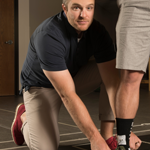
- Name: Jay Radke, Ph.D.
- Institution: Idaho Veterans Research and Education Foundation
- Department: Research
- Phone: 208-422-1000 x4049
- Email: jay.radke@va.gov
Summary: Research in my laboratory is focused on understanding how two highly related (99.9% genetically identical) human adenoviruses (Ad14 and Ad14p1) have such disparate pathogenesis. Ad14p1 is an emergent strain of Ad14 that induces a strong inflammatory response during infection that can result in severe, acute lung injury and, in some cases, leads to acute respiratory distress syndrome (ARDS). We have described a novel, immunorepressive activity of Ad infected dying cells (termed Ad CPE corpses) that modulate the Ad-induced, innate immune response. Ad CPE corpse repression of macrophage-mediated inflammatory responses requires expression of the Ad protein, E1B 19/20K. Ad CPE corpses resulting from infection with Ad that lack E1B 19K, fail to repress Ad-induced macrophage pro-inflammatory responses and, in contrast, can induce increases in such responses. We have shown that E1B 20K expression is reduced in Ad14p1 infection compared to Ad14 infection and that the resulting Ad14p1 CPE corpses fail to repress pro-inflammatory macrophage responses, whereas wt Ad14 CPE corpses are markedly immunorepressive. Recent data suggest that Ad14p1 infection alters expression of cellular microRNAs (miRNA) that are found in Ad14 infected cells that can regulate inflammatory cytokine expression. We are currently exploring the role of one of these miRNAs in regulating the immunorepressive activity of Ad14 CPE corpses. We have recently published a paper identifying and characterizing Ad14 encoding viral miRNAs. The role of these viral miRNAs in the viral life cycle and pathogenesis is not known but we have shown that Ad14p1 CPE corpses express significantly more of these viral miRNAs than Ad14 CPE corpses. Syrian hamsters are permissive for human adenoviruses as well as SARS-CoV-2. Infection of Syrian hamsters revealed that Ad14p1 infection induces a patchy bronchopneumonia that is not seen following infection with Ad14. Ad14p1 infected hamsters also show up-regulation of pro-inflammatory cytokines, consistent with our in vitro model system. This model system will allow us to test the role of miRNAs in the pathogenesis of Ad14p1 and to better characterize the immune responses that lead to Ad14p1 lung pathogenesis.
Minimum classes: Basic biology and chemistry courses
Projects: There are three on-going projects that students can join to help us understand Ad14p1 lung pathogenesis and improve the Syrian hamster as a model organism for studying viral pathogenesis including SARS-CoV-2.
Project 1) Creation of recombinant Ad14 and Ad14p1 viruses to test the role of virally encoded miRNA in modulating Ad14p1 pathogenesis. Techniques used would include: PCR, bacterial cell culture, site directed mutagenesis, homologous recombination, eukaryotic cell culture, adenovirus growth and purification.
Project 2) Improving the annotation of the Syrian hamster genome. Techniques used would include: RNA isolation, direct long-read RNA sequencing, bioinformatic analysis to identify novel (not annotated) genes and isoforms.
Project 3) Development and characterization of antibodies to Syrian hamster immune cell surface markers. Techniques used would include: PCR, hamster gene cloning, bacterial cell culture, eukaryotic cell culture, transfection of eukaryotic cells, flow cytometry, identification of antibody target epitopes by mass spectrometry.



